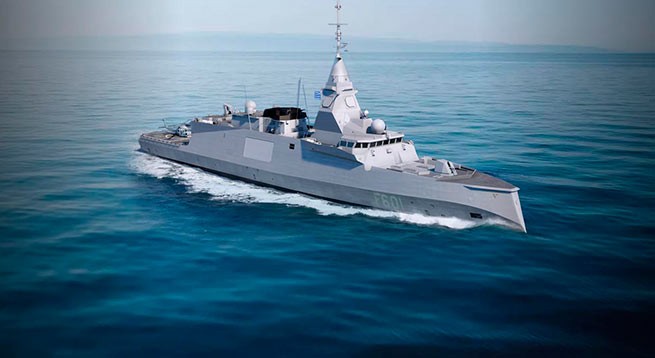The delivery of the first French-built frigate FDI-HN to Greece has been delayed by a year due to problems with the integration of the ship's radar and other sensors.
This means that at best, 2026, not 2025, is the optimal scenario for the delivery of the first frigate to the Navy, and from then on it is unknown when it will enter service.
Surprise? No, reality! The French Directorate of Naval Systems and the “system” promoting frigates in Greece, which promised “quick deliveries” to transfer to Greece ships with only rudimentary weapons, which would also be supplied to the French Navy and transform them from ships of military sovereignty into escort vessels.
This is far from what the Greek Navy expected. The first ship for the French fleet, Amiral Ronarc'h, will be delivered to the user not in the spring of 2024, but at least in 2025 (!), since sea trials are expected to begin no earlier than the summer. Since they are expected to last 6-8 months, the frigate is not expected to pass into the hands of Marine Nationale until – at best – early 2025 for operational testing. The same applies to the Greek ship Kimon.
It should be noted that the Thales Sea Fire radar that will be equipped on this class of ships has not even been activated yet! The tests alone, which of course cannot be carried out on board, will take a year. This will be the first time that the system located on the PSIM mainmast will work with all four AESA elementary beacons.
Until now, Sea Fire has only been tested in a special simulation mast configuration with two stoichiometers at a dedicated onshore facility on the Mediterranean coast of France. But its behavior in a real four-array PSIM installation, especially at sea and on a moving platform, hasn't even begun yet!
In other words, to meet delivery deadlines, the first FDI-FR (Amiral Ronarc'h) and the first Greek FDI-HN (KIMON) must be delivered simultaneously, which is practically impossible since the systems must be certified on a French vessel and then begin installation in Greek.
According to the agreement, the first ship of the series should be transferred to the Greek Navy in March 2026 and, under ideal conditions, enter service in 2027. However, as confirmed by numerous French publications, after Ronarc'h and KIMON in the shipbuilding order come NEARCHOS (as planned) and FORMION (i.e. the former Amiral Louzeau), and then Amiral Louzeau (instead of FORMION), the delivery of which is now not expected – at best, this will happen somewhere in 2029. It will be followed by Amiral Castex in 2028, Amiral Nomy in 2031 and Amiral Cabanier, all 2-3 years late.
In 2030, Greek frigates (according to the contract) should begin to be equipped with larger-capacity missile launch cells, so that the number of missiles will double, according to current information, to 32 pieces. It is assumed that the first ship will be ready for operation, i.e. delivered in 2025 and testing completed in 2026, the second in 2028 (very doubtful), and the third – if all goes well – in 2030 (even more doubtful), with a more likely date being 2032! If everything goes perfectly, in reality this will most likely not happen until 2033! And if new orders appear (the French want to push the class towards the Norwegians), then Greece’s queue will move even further back.
Note that two ships will be delivered without a self-protection system, active or passive, and without half of the anti-aircraft missiles, and it is hoped that the third will be a test platform that will allow them to achieve a common configuration. Its main armament will consist of 8 Exocet MM40 Block 3 surface-to-surface missiles and 16 Aster 30 vertical-launch anti-aircraft missiles.
In addition, the first and second ships built in French shipyards will also not have the RAM anti-missile system, which will be installed in the period 2030-32! That is, by that time they will be completely unsuitable and very easy targets for the Turkish fleet, with zero anti-missile potential!
As for deliveries, in the fall of 2024″ΚΙΜΩΝ” will begin basic operational testing in France, which will last until 2026, after which it is expected to be handed over to the Navy by the end of 2026, which will begin its own operational testing, and the ship will be operational, hopefully by 2027.
It should be noted that a second critical discount was made to the FDI's armament, as it would not be equipped with the SCALP NAVAL cruise missiles, which were excluded from the final configuration, preventing the PN from gaining strategic capability.
Unfortunately, this was the largest and most critical purchase for a frigate, which could have become a sea dominance ship with 8 SCALP NAVAL cruise missiles, 24 ASTER-30, STRALES and RAM guns, ECM system, etc., but instead it is being turned into a very expensive ship, doomed to be sunk in the first high-intensity naval conflict, since it will not be able to withstand a saturation attack, since it lacks basic missile defense.
The ship does not have a Strales system in the main gun (which would provide anti-missile protection), nor an IRST detection and targeting system to increase survivability!
As for those who are spreading false information that SCALP NAVAL missiles can be installed later, this cannot happen, since they require other “cells” to launch them, and the software for these missiles is not installed.
It is worth noting that the Greek Treasury has currently paid about 2 billion euros to France out of a total cost of 3.23 billion euros.
PS Taking into account the latest trends identified during the Russian-Ukrainian war, it is already clear that this frigate model will become obsolete even before it is launched. And by the 1930s it would become completely obsolete technology.







More Stories
Public opinion poll: 33.3% for ND versus 15.5% for SYRIZA, PASOK in third place with 12.1%
EU sends firefighters to Greece to fight fires
Poll: 30% for ND, K. Velopoulos "sank" up to 7%, A.Latinupulu on the threshold of 3%